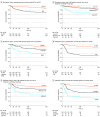Machine Learning Multicenter Risk Model to Predict Right Ventricular Failure After Mechanical Circulatory Support: The STOP-RVF Score
- PMID: 38294795
- PMCID: PMC10831631
- DOI: 10.1001/jamacardio.2023.5372
Machine Learning Multicenter Risk Model to Predict Right Ventricular Failure After Mechanical Circulatory Support: The STOP-RVF Score
Abstract
Importance: The existing models predicting right ventricular failure (RVF) after durable left ventricular assist device (LVAD) support might be limited, partly due to lack of external validation, marginal predictive power, and absence of intraoperative characteristics.
Objective: To derive and validate a risk model to predict RVF after LVAD implantation.
Design, setting, and participants: This was a hybrid prospective-retrospective multicenter cohort study conducted from April 2008 to July 2019 of patients with advanced heart failure (HF) requiring continuous-flow LVAD. The derivation cohort included patients enrolled at 5 institutions. The external validation cohort included patients enrolled at a sixth institution within the same period. Study data were analyzed October 2022 to August 2023.
Exposures: Study participants underwent chronic continuous-flow LVAD support.
Main outcome and measures: The primary outcome was RVF incidence, defined as the need for RV assist device or intravenous inotropes for greater than 14 days. Bootstrap imputation and adaptive least absolute shrinkage and selection operator variable selection techniques were used to derive a predictive model. An RVF risk calculator (STOP-RVF) was then developed and subsequently externally validated, which can provide personalized quantification of the risk for LVAD candidates. Its predictive accuracy was compared with previously published RVF scores.
Results: The derivation cohort included 798 patients (mean [SE] age, 56.1 [13.2] years; 668 male [83.7%]). The external validation cohort included 327 patients. RVF developed in 193 of 798 patients (24.2%) in the derivation cohort and 107 of 327 patients (32.7%) in the validation cohort. Preimplant variables associated with postoperative RVF included nonischemic cardiomyopathy, intra-aortic balloon pump, microaxial percutaneous left ventricular assist device/venoarterial extracorporeal membrane oxygenation, LVAD configuration, Interagency Registry for Mechanically Assisted Circulatory Support profiles 1 to 2, right atrial/pulmonary capillary wedge pressure ratio, use of angiotensin-converting enzyme inhibitors, platelet count, and serum sodium, albumin, and creatinine levels. Inclusion of intraoperative characteristics did not improve model performance. The calculator achieved a C statistic of 0.75 (95% CI, 0.71-0.79) in the derivation cohort and 0.73 (95% CI, 0.67-0.80) in the validation cohort. Cumulative survival was higher in patients composing the low-risk group (estimated <20% RVF risk) compared with those in the higher-risk groups. The STOP-RVF risk calculator exhibited a significantly better performance than commonly used risk scores proposed by Kormos et al (C statistic, 0.58; 95% CI, 0.53-0.63) and Drakos et al (C statistic, 0.62; 95% CI, 0.57-0.67).
Conclusions and relevance: Implementing routine clinical data, this multicenter cohort study derived and validated the STOP-RVF calculator as a personalized risk assessment tool for the prediction of RVF and RVF-associated all-cause mortality.
Conflict of interest statement
Figures


References
-
- Kormos RL, Teuteberg JJ, Pagani FD, et al. ; HeartMate II Clinical Investigators . Right ventricular failure in patients with the HeartMate II continuous-flow left ventricular assist device: incidence, risk factors, and effect on outcomes. J Thorac Cardiovasc Surg. 2010;139(5):1316-1324. doi:10.1016/j.jtcvs.2009.11.020 - DOI - PubMed
Publication types
MeSH terms
Grants and funding
LinkOut - more resources
Full Text Sources
Medical
Research Materials
Miscellaneous

